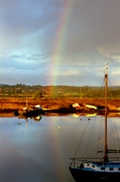
Cycling in the wine hills of Romagna
Riccione, Italy March 17, 2007 I returned earlier this week from a visit to the wine hills of Italy's Romagna, the eastern section of the region of Emilia-Romagna that extends down to the Adriatic sea. Emilia-Romagna is known as the belly of Italy, since it is the source of so many good things to eat, notably parmigiano reggiano, prosciutto di Parma, aceto balsamico tradizionale di Modena, mortadella, handmade egg pasta, ragù, tortellini, piadina and much else.
The main reason for my visit was not wine but cycling. I spent a fantastic week with Colin Lewis (ex-Tour de France rider), and friends Phil D-M and Kevin F, cycling into the foothills of the Apennines and up and around San Marino. The cycling was hard but fantastic, and afterwards we relaxed, drinking some very good wines accompanied by the ample and delicious foods of the region.
For me, apart from the cycling, there were two particular highlights. We discovered an astonishing red wine called Burson made from the grape Uva Longanesi, a little known pre-phyloxera variety discovered some 200 years ago in vineyards surrounding a monastery not far from Ravenna. It's quite probable the variety dates back to Roman times. The wine made today is immense, a real blockbuster, with dense, blackberry fruit overlayering dried fruit flavours such as figs and raisins; in the mouth it's incredibly velvety (the wine ages in new French oak barrique), with a long, lovely and persistent finish. Just the sort of rich, warming wine to spin out when feeling totally exhausted, after a day spent spinning up those savage hills.
The other remarkable discovery is a fascinating cheese: formaggio di fossa. A 'fossa' is a pit or a hole in the ground, in this instance carved into the soft sandstone rock upon which the hilltop castelli di Romagna are built. To make formaggio di fossa, young 3 month old pecorino cheeses are first stacked in cloths, then arranged in these circular, underground, conical pits that are some four metres deep. Once the cheeses have been so arranged, the pits full of some thousands of cheeses, they are then completely sealed with a stone that is further made airtight with cement. The cheeses thus age anaerobically and undergo a secondary fermentation. In the process, they lose both fat and whey, which drains off. The cheeses that eventually emerge from this lengthy (around 3 month) underground sojourn are quite unlike any other that I've tasted: rather soft and creamy in texture, with deep, pungent flavours that are at once, paradoxically, forthright yet also somehow delicate, no where near as strong as you might imagine. We enjoyed formaggio di fossa after cycling to an agriturismo farmhouse, the cheese delicious dribbled with a little acacia honey.
For cycling holidays in Romagna (at whatever level, from leisurely to, well, let's say downright painful) the Hotel Dory in Riccione makes a superb base. There are brand new Scott CR1 carbon-fibre bicycles available to hire, and expert guides take out groups of varying levels into the stunningly beautiful and always challenging countryside. Afterwards there is a spa to rejuvenate weary limbs and meals that are at once outrageously ample as well as delicious.
For more information visit www.hoteldory.it
![]()
|Home| |QP New Media| |Kim's Gallery|
Copyright © Marc and Kim Millon 1997-2006
![]()
